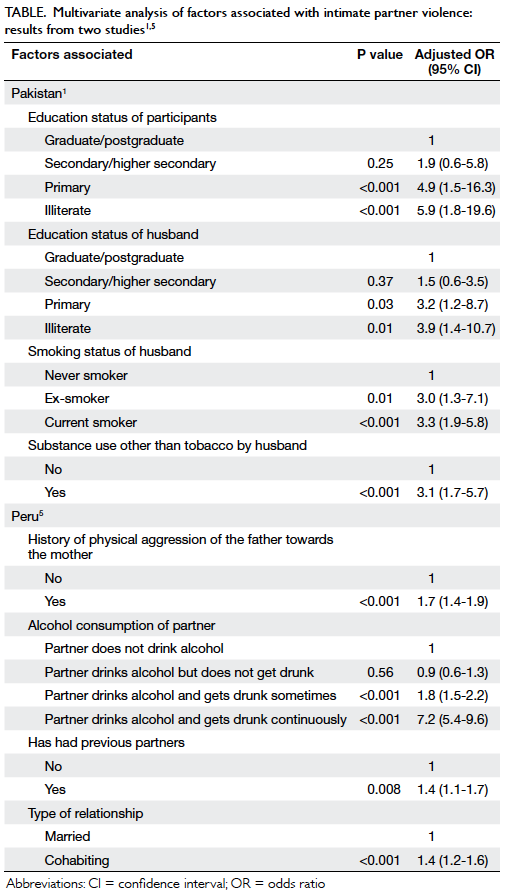DOI: 10.12809/hkmj144335
© Hong Kong Academy of Medicine. CC BY-NC-ND 4.0
LETTER TO THE EDITOR
Intimate partner violence against women: the Peruvian case
Jhon W Mejía-Dolores
Sociedad Científica San Fernando, Universidad Nacional Mayor de San Marcos (UNMSM). Facultad de Medicina de San Fernando, Lima, Perú
Corresponding author: Dr Jhon W Mejía-Dolores (jmejiad3@gmail.com)
To the Editor—In their original article, Ali et al1 state
that in Karachi, the biggest city of Pakistan which
is a country with an illiteracy rate of 45.1%,2 and one
of the three countries with highest consumption of
opiates,3 the factors most commonly associated with
intimate partner violence (IPV) include illiteracy
of women (odds ratio [OR]=5.9; 95% confidence
interval [CI], 1.8-19.6), illiteracy of husbands
(OR=3.9; 95% CI, 1.4-10.7), current smoker status of
husbands (OR=3.3; 95% CI, 1.9-5.8), and substance
use other than tobacco by husbands (OR=3.1; 95%
CI, 1.7-5.7).
Peru is a South American country where
more alcohol is consumed per capita (8.1 L) than
the average consumption in the rest of the world
(6.1 L).4 According to Blitchtein-Winicki and Reyes-Solari,5 alcohol consumption is the factor most
commonly associated with IPV (OR=7.2; 95% CI,
5.4-9.6), along with a history of physical aggression
of the father towards the mother (OR=1.7; 95% CI,
1.4-1.9). Other factors associated with increased
risk of IPV include having previous partners
(OR=1.4; 95% CI, 1.1-1.7) and cohabiting (OR=1.4;
95% CI, 1.2-1.6). This apparent difference in factors
associated with IPV could be explained by the
ecological theory according to which, to properly
approach this phenomenon, one must take into
account the interaction of factors at different levels
of analysis, namely, individual, family relationships,
relationships with others, and social. Thus, in
different cultures, we find the same phenomenon
but different causes associated with IPV (Table).1 5

Table. Multivariate analysis of factors associated with intimate partner violence: results from two studies1 5
References
1. Ali NS, Ali FN, Khuwaja AK, Nanji K. Factors associated
with intimate partner violence against women in a mega
city of South-Asia: multi-centre cross-sectional study.
Hong Kong Med J 2014;20:297-303. CrossRef
2. UNESCO. Adult and youth literacy. National, regional
and global trends, 1985-2015. Quebec: UNESCO Institute
for Statistics; 2013. Available from: http://www.uis.unesco.org/Education/Documents/literacy-statistics-trends-1985-2015.pdf. Accessed Jun 2014.
3. UNODC. World Drug Report 2012. Viena: UNODC;
2012. Available from: http://www.unodc.org/documents/data-and-analysis/WDR2012/WDR_2012_web_small.pdf.
Accessed Jun 2014.
4. World Health Organization (2010b). Global status report
on alcohol and health 2014. WHO Library Cataloguing-in-Publication Data. Luxembourg. Available from: http://apps.who.int/iris/bitstream/10665/112736/1/9789240692763_eng.pdf. Accessed Jun 2014.
5. Blitchtein-Winicki D, Reyes-Solari E. Factors associated to
recent intimate partner physical violence against women
in Peru, 2004-2007 [in Spanish]. Rev Peru Med Exp Salud
Publica 2012;29:35-43. CrossRef

